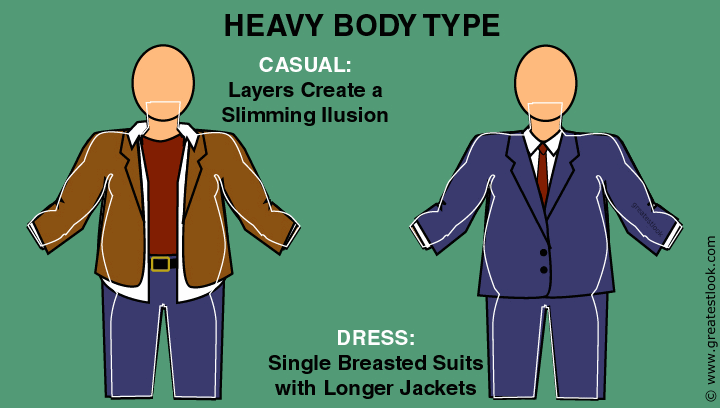Wearing Clothes Well

The Three Basic Body Types for Men
Having the right clothes for a particular occasion is really only a part of what you need to look good. If the clothes you have don't properly fit, you can end up looking unkempt and disheveled. And the problem is equally troublesome whether your clothing is too big or too small. Yet, most men don't understand this fact. Instead, they spend their hard-earned money to buy nice, new clothing, and end up looking like they're wearing hand-me-downs.
However, here are some tips for ensuring a good fit and a flattering look in the clothing you wear. It all depends on your body type. Regardless of size, there are three basic body types: Heavy, Muscular, and Slim.
This body type covers those men who are overweight, particularly those who are barrel-chested or have a large belly. Unfortunately, many men who are overweight feel that the best way to camouflage their girth is to wear loose clothing. The irony is that this gambit only serves to exaggerate the individual's size. It has the added effect of often creating a slovenly impression.
Of course, there are also those heavy men who don't seem to realize that they are the size they are. These men insist on wearing clothing that is just a little too small. This also emphasizes the individual's girth rather than minimizing it.
The big man needs to remember that while his clothes must be larger in size than those of his more svelte counterparts, fit is still of utmost importance. Suits and sport coats should be measured using the chest measurement (normal) or the waist measurement, whichever is greater. This will allow these coats to be fastened smoothly across the waist without stress or gaps. The suit coats and sport coats should also be purchased so that they are slightly longer on the torso than for average-sized men. This will emphasize the vertical lines of the clothing and create a slimming effect.
Dress shirts, and casual dress shirts often present a special problem. They, of course, should also be purchased of a size to allow for being fastened smoothly across the waist. However, the heavy man often finds that needs to buy a shirt (which is sized by neck measurement) that is baggy at the waist in order to have a proper fit at the neck. Such a shirt should be taken to a tailor/seamstress and be altered for a proper fit in the waist. Failure to do so results in the shirt being "puffy" at the waist from being tucked in and making the individual look larger.
For casual knit shirts (polo shirts, jersey pullovers, etc.) make sure that the garment fits smoothly over the waist without stressing or stretching the fabric. Otherwise, the shirts will soon be stretched out and appear shabby.
Another tip for slimming the heavy man's physique is layering. This works best with casual clothing. By wearing a close-fitting shirt on the bottom layer (tucked into the pants), and adding a button up shirt as an overlay, we create the needed vertical lines to stretch the torso and make the individual look slimmer. By adding a sport coat over the un-tucked overlay shirt, we create an illusion of a lower waist and a longer torso.
Finally, one of the biggest mistakes many heavy men make is buying and wearing pleat-front pants. The idea behind pleat-front pants is to create the impression of a smaller waist. It is an idea that DOES NOT WORK. On a heavy man, pleated pants merely emphasize the waist, creating a focus on the horizontal line of the waist. Instead, choose a smooth front pant that fits comfortably across the middle in order to keep the vertical line smooth.
Take a look at the above graphic for an example of the effects of proper fit in clothing for the heavy man.
Next Page